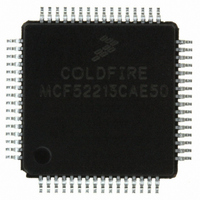MCF52213CAE50 Freescale Semiconductor, MCF52213CAE50 Datasheet - Page 10

MCF52213CAE50
Manufacturer Part Number
MCF52213CAE50
Description
IC MCU 32BIT 128K FLASH 64-LQFP
Manufacturer
Freescale Semiconductor
Series
MCF5221xr
Datasheet
1.MCF52213CAE50.pdf
(56 pages)
Specifications of MCF52213CAE50
Core Processor
Coldfire V2
Core Size
32-Bit
Speed
50MHz
Connectivity
I²C, SPI, UART/USART, USB OTG
Peripherals
DMA, LVD, POR, PWM, WDT
Number Of I /o
56
Program Memory Size
128KB (128K x 8)
Program Memory Type
FLASH
Ram Size
8K x 8
Voltage - Supply (vcc/vdd)
3 V ~ 3.6 V
Data Converters
A/D 8x12b
Oscillator Type
Internal
Operating Temperature
-40°C ~ 85°C
Package / Case
64-LQFP
Processor Series
MCF522x
Core
ColdFire V2
Data Bus Width
32 bit
Data Ram Size
8 KB
Interface Type
I2C, QSPI, UART
Maximum Clock Frequency
50 MHz
Number Of Programmable I/os
43
Number Of Timers
18
Maximum Operating Temperature
+ 85 C
Mounting Style
SMD/SMT
3rd Party Development Tools
JLINK-CF-BDM26, EWCF
Development Tools By Supplier
M52210DEMO, M52211EVB
Minimum Operating Temperature
- 40 C
On-chip Adc
12 bit, 8 Channel
A/d Bit Size
12 bit
A/d Channels Available
8
Height
1.4 mm
Length
10 mm
Supply Voltage (max)
3.6 V
Supply Voltage (min)
3 V
Width
10 mm
For Use With
M52210DEMO - BOARD DEV MCF5221X LOW COST
Lead Free Status / RoHS Status
Lead free / RoHS Compliant
Eeprom Size
-
Lead Free Status / Rohs Status
Details
Available stocks
Company
Part Number
Manufacturer
Quantity
Price
Company:
Part Number:
MCF52213CAE50
Manufacturer:
Freescale Semiconductor
Quantity:
10 000
1.2.7
The device includes a Universal Serial Bus On-The-Go (USB OTG) dual-mode controller. USB is a popular standard for
connecting peripherals and portable consumer electronic devices such as digital cameras and handheld computers to host PCs.
The OTG supplement to the USB specification extends USB to peer-to-peer application, enabling devices to connect directly
to each other without the need for a PC. The dual-mode controller on the device can act as a USB OTG host and as a USB
device. It also supports full-speed and low-speed modes.
1.2.8
The device has three full-duplex UARTs that function independently. The three UARTs can be clocked by the system bus clock,
eliminating the need for an external clock source. On smaller packages, the third UART is multiplexed with other digital I/O
functions.
1.2.9
The processor includes two I
a simple, efficient method of data exchange and minimizes the interconnection between devices. This bus is suitable for
applications requiring occasional communications over a short distance between many devices.
1.2.10
The queued serial peripheral interface (QSPI) provides a synchronous serial peripheral interface with queued transfer capability.
It allows up to 16 transfers to be queued at once, minimizing the need for CPU intervention between transfers.
1.2.11
The fast ADC consists of an eight-channel input select multiplexer and two independent sample and hold (S/H) circuits feeding
separate 12-bit ADCs. The two separate converters store their results in accessible buffers for further processing.
The ADC can be configured to perform a single scan and halt, a scan when triggered, or a programmed scan sequence repeatedly
until manually stopped.
The ADC can be configured for sequential or simultaneous conversion. When configured for sequential conversions, up to eight
channels can be sampled and stored in any order specified by the channel list register. Both ADCs may be required during a
scan, depending on the inputs to be sampled.
During a simultaneous conversion, both S/H circuits are used to capture two different channels at the same time. This
configuration requires that a single channel may not be sampled by both S/H circuits simultaneously.
Optional interrupts can be generated at the end of the scan sequence if a channel is out of range (measures below the low
threshold limit or above the high threshold limit set in the limit registers) or at several different zero crossing conditions.
1.2.12
There are four independent, DMA transfer capable 32-bit timers (DTIM0, DTIM1, DTIM2, and DTIM3) on the device. Each
module incorporates a 32-bit timer with a separate register set for configuration and control. The timers can be configured to
operate from the system clock or from an external clock source using one of the DTINn signals. If the system clock is selected,
it can be divided by 16 or 1. The input clock is further divided by a user-programmable 8-bit prescaler that clocks the actual
timer counter register (TCRn). Each of these timers can be configured for input capture or reference (output) compare mode.
Timer events may optionally cause interrupt requests or DMA transfers.
Freescale Semiconductor
USB On-The-Go Controller
UARTs
I
QSPI
Fast ADC
DMA Timers (DTIM0–DTIM3)
2
C Bus
2
C modules. The I
MCF52211 ColdFire Microcontroller, Rev. 2
2
C bus is an industry-standard, two-wire, bidirectional serial bus that provides
Family Configurations
10











